window FIAT DOBLO COMBI 2018 Owner handbook (in English)
[x] Cancel search | Manufacturer: FIAT, Model Year: 2018, Model line: DOBLO COMBI, Model: FIAT DOBLO COMBI 2018Pages: 272, PDF Size: 23.75 MB
Page 41 of 272

Air flow distributed between footwell diffusers (hotter air) and central and side dashboard vents (cooler air). This
distribution mode is particularly useful in spring and autumn on sunny days.
Air flow distributed between the footwell vents and the windscreen and front side window defrosting/demisting vents.
This allows an adequate warming of the passenger compartment and prevents the windows from misting up.
C Display.
D MAX DEF function control button.
E System deactivation button.
F Compressor on/off control button.
G Air recirculation control button.
H Fan speed increase/decrease control buttons.
I Temperature increase/decrease control knob.
L Heated rear window and electric door mirror on/off button (for versions/markets, where provided).
39
Page 42 of 272
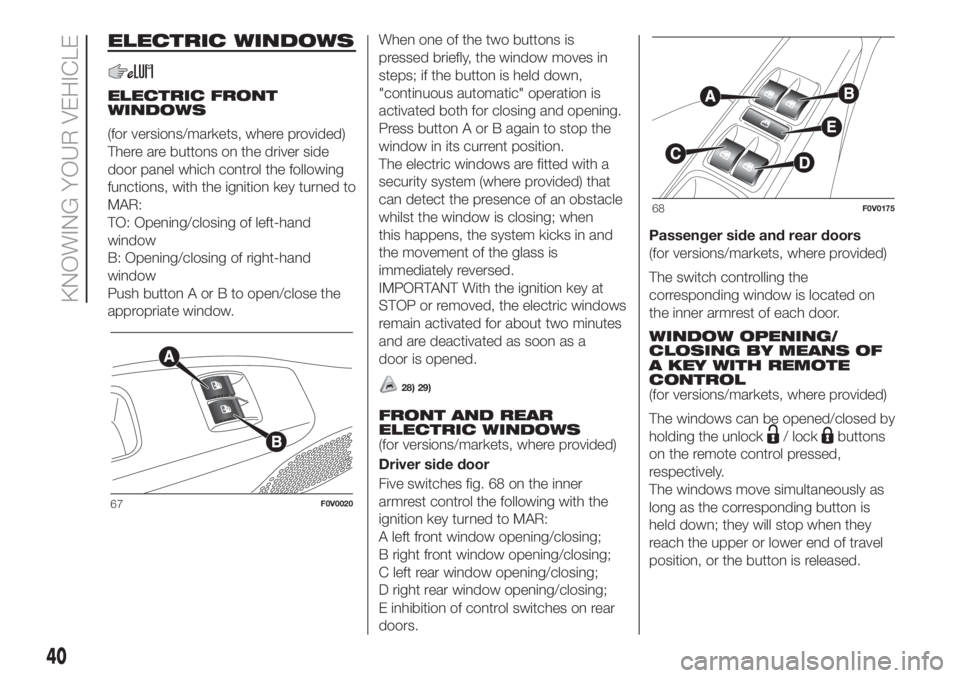
ELECTRIC WINDOWS
ELECTRIC FRONT
WINDOWS
(for versions/markets, where provided)
There are buttons on the driver side
door panel which control the following
functions, with the ignition key turned to
MAR:
TO: Opening/closing of left-hand
window
B: Opening/closing of right-hand
window
Push button A or B to open/close the
appropriate window.When one of the two buttons is
pressed briefly, the window moves in
steps; if the button is held down,
"continuous automatic" operation is
activated both for closing and opening.
Press button A or B again to stop the
window in its current position.
The electric windows are fitted with a
security system (where provided) that
can detect the presence of an obstacle
whilst the window is closing; when
this happens, the system kicks in and
the movement of the glass is
immediately reversed.
IMPORTANT With the ignition key at
STOP or removed, the electric windows
remain activated for about two minutes
and are deactivated as soon as a
door is opened.
28) 29)
FRONT AND REAR
ELECTRIC WINDOWS
(for versions/markets, where provided)
Driver side door
Five switches fig. 68 on the inner
armrest control the following with the
ignition key turned to MAR:
A left front window opening/closing;
B right front window opening/closing;
C left rear window opening/closing;
D right rear window opening/closing;
E inhibition of control switches on rear
doors.Passenger side and rear doors
(for versions/markets, where provided)
The switch controlling the
corresponding window is located on
the inner armrest of each door.
WINDOW OPENING/
CLOSING BY MEANS OF
A KEY WITH REMOTE
CONTROL
(for versions/markets, where provided)
The windows can be opened/closed by
holding the unlock
/ lockbuttons
on the remote control pressed,
respectively.
The windows move simultaneously as
long as the corresponding button is
held down; they will stop when they
reach the upper or lower end of travel
position, or the button is released.
67F0V0020
68F0V0175
40
KNOWING YOUR VEHICLE
Page 43 of 272
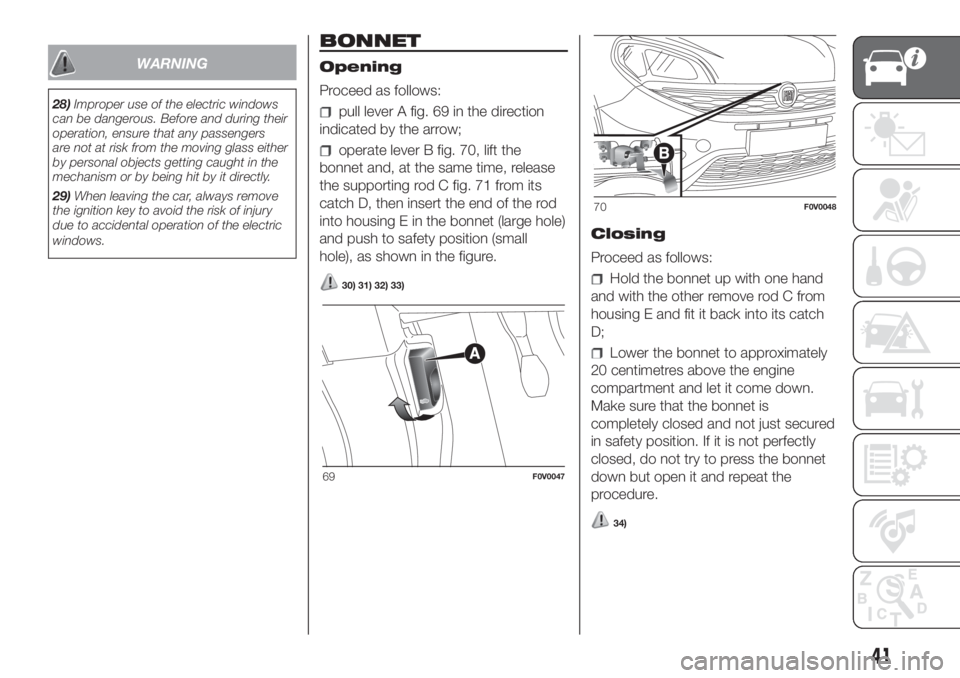
WARNING
28)Improper use of the electric windows
can be dangerous. Before and during their
operation, ensure that any passengers
are not at risk from the moving glass either
by personal objects getting caught in the
mechanism or by being hit by it directly.
29)When leaving the car, always remove
the ignition key to avoid the risk of injury
due to accidental operation of the electric
windows.
BONNET
Opening
Proceed as follows:
pull lever A fig. 69 in the direction
indicated by the arrow;
operate lever B fig. 70, lift the
bonnet and, at the same time, release
the supporting rod C fig. 71 from its
catch D, then insert the end of the rod
into housing E in the bonnet (large hole)
and push to safety position (small
hole), as shown in the figure.
30) 31) 32) 33)
Closing
Proceed as follows:
Hold the bonnet up with one hand
and with the other remove rod C from
housing E and fit it back into its catch
D;
Lower the bonnet to approximately
20 centimetres above the engine
compartment and let it come down.
Make sure that the bonnet is
completely closed and not just secured
in safety position. If it is not perfectly
closed, do not try to press the bonnet
down but open it and repeat the
procedure.
34)
69F0V0047
70F0V0048
41
Page 103 of 272
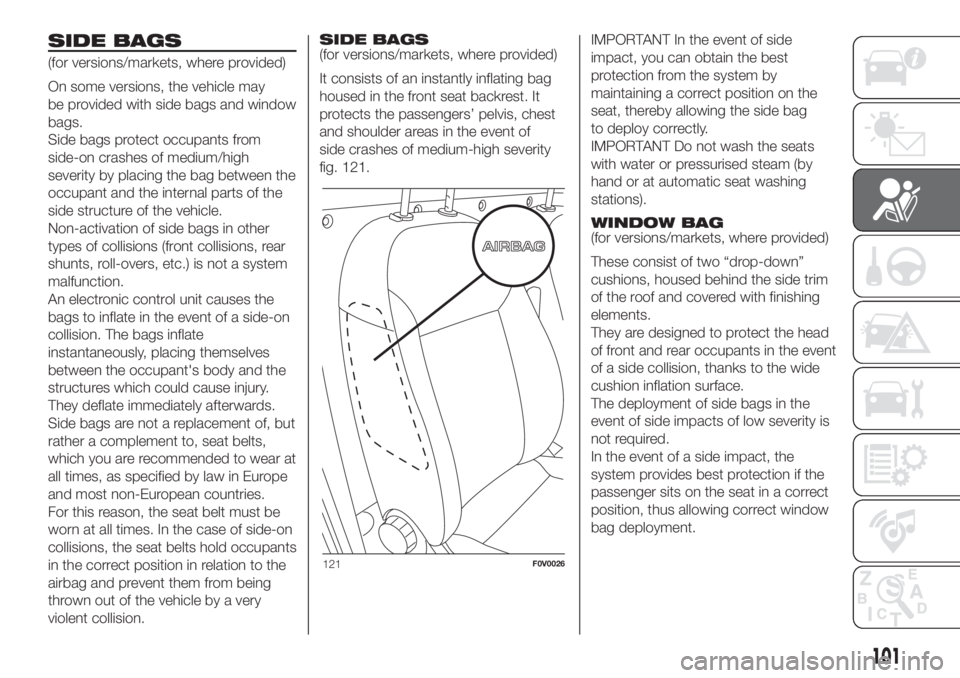
SIDE BAGS
(for versions/markets, where provided)
On some versions, the vehicle may
be provided with side bags and window
bags.
Side bags protect occupants from
side-on crashes of medium/high
severity by placing the bag between the
occupant and the internal parts of the
side structure of the vehicle.
Non-activation of side bags in other
types of collisions (front collisions, rear
shunts, roll-overs, etc.) is not a system
malfunction.
An electronic control unit causes the
bags to inflate in the event of a side-on
collision. The bags inflate
instantaneously, placing themselves
between the occupant's body and the
structures which could cause injury.
They deflate immediately afterwards.
Side bags are not a replacement of, but
rather a complement to, seat belts,
which you are recommended to wear at
all times, as specified by law in Europe
and most non-European countries.
For this reason, the seat belt must be
worn at all times. In the case of side-on
collisions, the seat belts hold occupants
in the correct position in relation to the
airbag and prevent them from being
thrown out of the vehicle by a very
violent collision.SIDE BAGS
(for versions/markets, where provided)
It consists of an instantly inflating bag
housed in the front seat backrest. It
protects the passengers’ pelvis, chest
and shoulder areas in the event of
side crashes of medium-high severity
fig. 121.IMPORTANT In the event of side
impact, you can obtain the best
protection from the system by
maintaining a correct position on the
seat, thereby allowing the side bag
to deploy correctly.
IMPORTANT Do not wash the seats
with water or pressurised steam (by
hand or at automatic seat washing
stations).
WINDOW BAG
(for versions/markets, where provided)
These consist of two “drop-down”
cushions, housed behind the side trim
of the roof and covered with finishing
elements.
They are designed to protect the head
of front and rear occupants in the event
of a side collision, thanks to the wide
cushion inflation surface.
The deployment of side bags in the
event of side impacts of low severity is
not required.
In the event of a side impact, the
system provides best protection if the
passenger sits on the seat in a correct
position, thus allowing correct window
bag deployment.
121F0V0026
101
Page 104 of 272
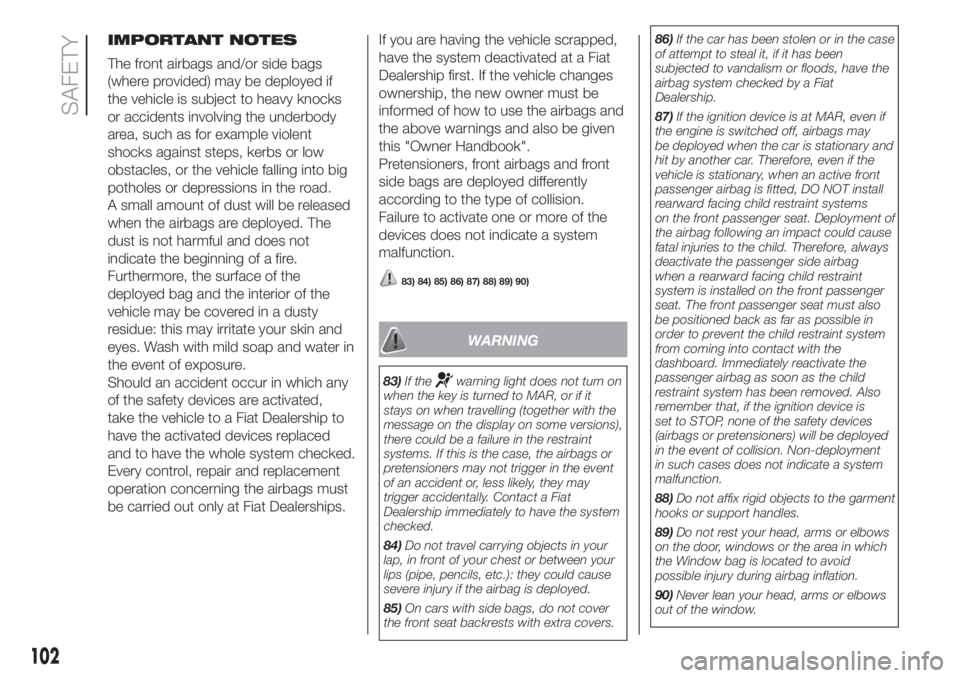
IMPORTANT NOTES
The front airbags and/or side bags
(where provided) may be deployed if
the vehicle is subject to heavy knocks
or accidents involving the underbody
area, such as for example violent
shocks against steps, kerbs or low
obstacles, or the vehicle falling into big
potholes or depressions in the road.
A small amount of dust will be released
when the airbags are deployed. The
dust is not harmful and does not
indicate the beginning of a fire.
Furthermore, the surface of the
deployed bag and the interior of the
vehicle may be covered in a dusty
residue: this may irritate your skin and
eyes. Wash with mild soap and water in
the event of exposure.
Should an accident occur in which any
of the safety devices are activated,
take the vehicle to a Fiat Dealership to
have the activated devices replaced
and to have the whole system checked.
Every control, repair and replacement
operation concerning the airbags must
be carried out only at Fiat Dealerships.If you are having the vehicle scrapped,
have the system deactivated at a Fiat
Dealership first. If the vehicle changes
ownership, the new owner must be
informed of how to use the airbags and
the above warnings and also be given
this "Owner Handbook".
Pretensioners, front airbags and front
side bags are deployed differently
according to the type of collision.
Failure to activate one or more of the
devices does not indicate a system
malfunction.
83) 84) 85) 86) 87) 88) 89) 90)
WARNING
83)If thewarning light does not turn on
when the key is turned to MAR, or if it
stays on when travelling (together with the
message on the display on some versions),
there could be a failure in the restraint
systems. If this is the case, the airbags or
pretensioners may not trigger in the event
of an accident or, less likely, they may
trigger accidentally. Contact a Fiat
Dealership immediately to have the system
checked.
84)Do not travel carrying objects in your
lap, in front of your chest or between your
lips (pipe, pencils, etc.): they could cause
severe injury if the airbag is deployed.
85)On cars with side bags, do not cover
the front seat backrests with extra covers.86)If the car has been stolen or in the case
of attempt to steal it, if it has been
subjected to vandalism or floods, have the
airbag system checked by a Fiat
Dealership.
87)If the ignition device is at MAR, even if
the engine is switched off, airbags may
be deployed when the car is stationary and
hit by another car. Therefore, even if the
vehicle is stationary, when an active front
passenger airbag is fitted, DO NOT install
rearward facing child restraint systems
on the front passenger seat. Deployment of
the airbag following an impact could cause
fatal injuries to the child. Therefore, always
deactivate the passenger side airbag
when a rearward facing child restraint
system is installed on the front passenger
seat. The front passenger seat must also
be positioned back as far as possible in
order to prevent the child restraint system
from coming into contact with the
dashboard. Immediately reactivate the
passenger airbag as soon as the child
restraint system has been removed. Also
remember that, if the ignition device is
set to STOP, none of the safety devices
(airbags or pretensioners) will be deployed
in the event of collision. Non-deployment
in such cases does not indicate a system
malfunction.
88)Do not affix rigid objects to the garment
hooks or support handles.
89)Do not rest your head, arms or elbows
on the door, windows or the area in which
the Window bag is located to avoid
possible injury during airbag inflation.
90)Never lean your head, arms or elbows
out of the window.
102
SAFETY
Page 133 of 272
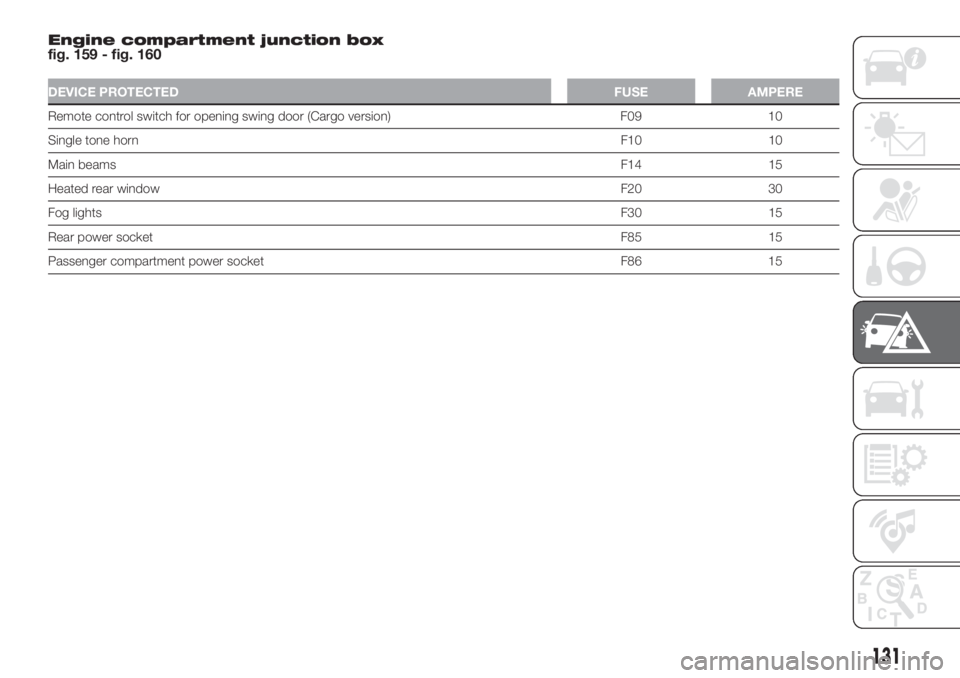
Engine compartment junction box
fig. 159 - fig. 160
DEVICE PROTECTEDFUSE AMPERE
Remote control switch for opening swing door (Cargo version) F09 10
Single tone hornF10 10
Main beamsF14 15
Heated rear windowF20 30
Fog lightsF30 15
Rear power socketF85 15
Passenger compartment power socket F86 15
131
Page 134 of 272

Passenger compartment fuse boxes
fig. 161 - fig. 162
DEVICE PROTECTEDFUSE AMPERE
Door locking/unlocking motors, dead lock actuator motors, tailgate unlocking motor F38 20
Supply + battery for EOBD diagnosis socket, radio, tyre pressure monitoring control unit F36 10
Windscreen/rear window washer pump F43 15
Window winder motor for front door passenger side F48 20
Left low beam, headlight corrector F13 7.5
Window winder motor for front door driver's side F47 20
Heated driver seatF1 10
Heated passenger seatF2 10
Cigarette lighterF3 15
Third power socket on dashboard F4 20
Driver's side rear electric window F5 20
Passenger's side rear electric window F6 20
WARNING
118)If the replaced fuse blows again, contact a Fiat Dealership.
119)Never replace a fuse with another with a higher amp rating; DANGER OF FIRE. If a general protection fuse (MEGA-FUSE, MIDI-FUSE) is
activated, contact a Fiat Dealership. Before replacing a fuse, make sure that the ignition key has been removed and that all the other services
are switched off and/or disengaged.
120)Contact a Fiat Dealership if a safety system (airbags, brakes), engine system (engine, gearbox) or steering system general protection
fuse blows.
132
IN AN EMERGENCY
Page 135 of 272
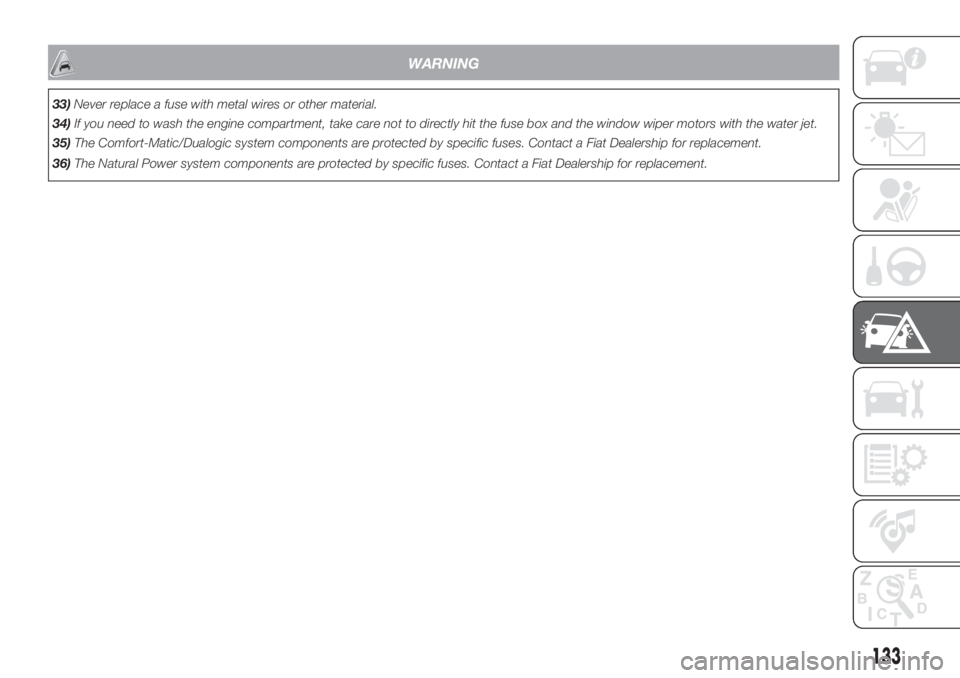
WARNING
33)Never replace a fuse with metal wires or other material.
34)If you need to wash the engine compartment, take care not to directly hit the fuse box and the window wiper motors with the water jet.
35)The Comfort-Matic/Dualogic system components are protected by specific fuses. Contact a Fiat Dealership for replacement.
36)The Natural Power system components are protected by specific fuses. Contact a Fiat Dealership for replacement.
133
Page 146 of 272
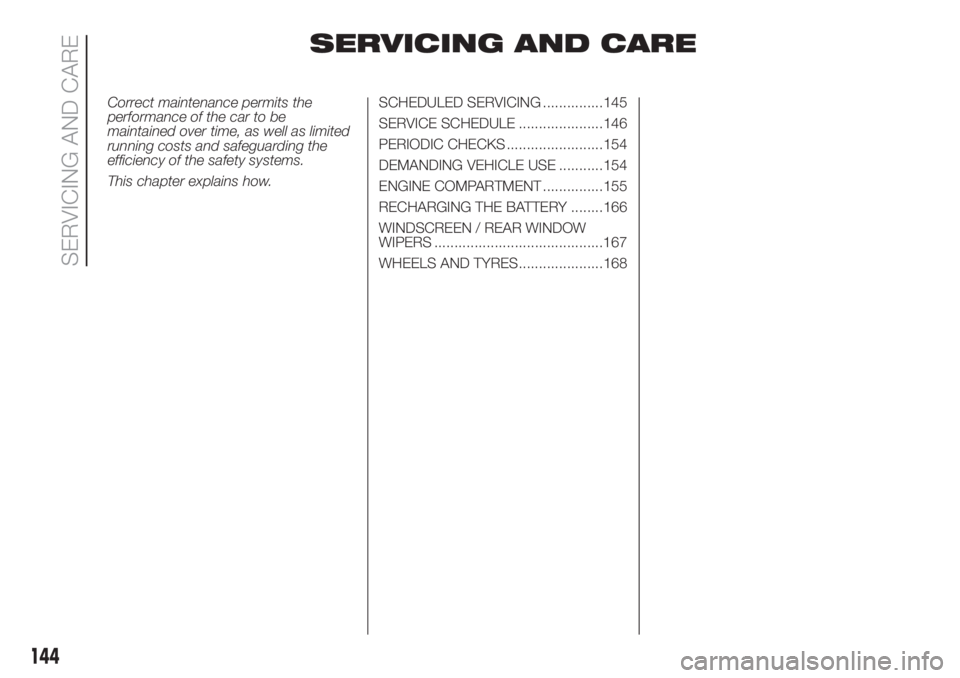
SERVICING AND CARE
Correct maintenance permits the
performance of the car to be
maintained over time, as well as limited
running costs and safeguarding the
efficiency of the safety systems.
This chapter explains how.SCHEDULED SERVICING ...............145
SERVICE SCHEDULE .....................146
PERIODIC CHECKS ........................154
DEMANDING VEHICLE USE ...........154
ENGINE COMPARTMENT ...............155
RECHARGING THE BATTERY ........166
WINDSCREEN / REAR WINDOW
WIPERS ..........................................167
WHEELS AND TYRES.....................168
144
SERVICING AND CARE
Page 149 of 272
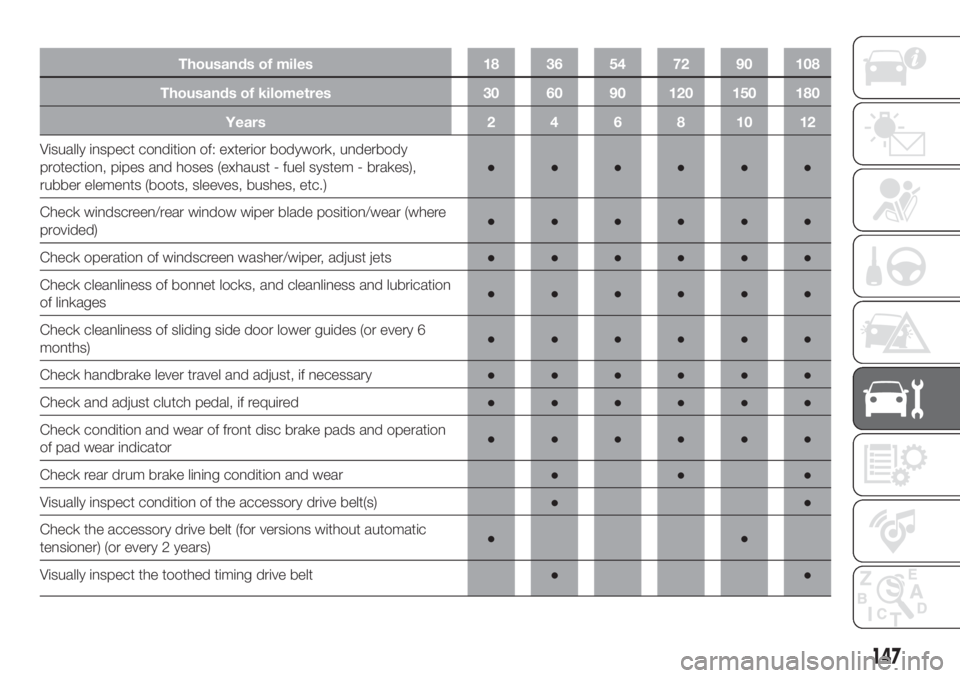
147
Thousands of miles 18 36 54 72 90 108
Thousands of kilometres 30 60 90 120 150 180
Years 2 4 6 8 10 12
Visually inspect condition of: exterior bodywork, underbody
protection, pipes and hoses (exhaust - fuel system - brakes),
rubber elements (boots, sleeves, bushes, etc.)●●●●●●
Check windscreen/rear window wiper blade position/wear (where
provided)●●●●●●
Check operation of windscreen washer/wiper, adjust jets●●●●●●
Check cleanliness of bonnet locks, and cleanliness and lubrication
of linkages●●●●●●
Check cleanliness of sliding side door lower guides (or every 6
months)●●●●●●
Check handbrake lever travel and adjust, if necessary●●●●●●
Check and adjust clutch pedal, if required●●●●●●
Check condition and wear of front disc brake pads and operation
of pad wear indicator●●●●●●
Check rear drum brake lining condition and wear●●●
Visually inspect condition of the accessory drive belt(s)●●
Check the accessory drive belt (for versions without automatic
tensioner) (or every 2 years)●●
Visually inspect the toothed timing drive belt●●